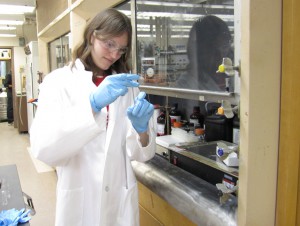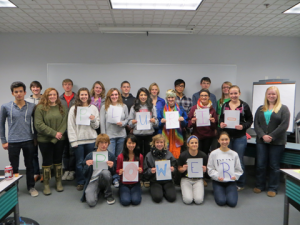
Ellyn credits the program with helping her achieve her goals:
“Over the course of two years in which I was a Youth Apprentice, I obtained numerous skills, both inside and outside of the lab. I gained valuable scientific experience, including techniques like gel electrophoresis, nucleic acid purification, PCR, SDS-PAGE, Western blotting, cell culture and more.
On a personal level, I became very close with other students in the class and with our instructors, Barbara Bielec and Chad Zimprich. Everyone involved was always very approachable and willing to help with both laboratory tasks and in terms of giving advice for the future.
Through the program, I was placed in Dr. Que Lan’s entomology lab at UW-Madison, beginning in 2009. While there, I worked on a project involving sterol carrier protein-2, a protein involved in cholesterol uptake in mosquitoes.Notably, I am still working in Dr. Lan’s lab, however my research focus has shifted to bacterial fermentation. In between working in Dr. Lan’s lab, I also worked at the Forest Products Laboratory (USDA).
Additionally, this past June, I began an internship at Promega in the Scientific Applications department. Here I work to develop new applications for existing projects. This November marks five years of laboratory research for me, which would not have been possible without the Youth Apprenticeship Program and everyone involved. In addition to the specific labs that I have had the opportunity to work in, my experience in the Youth Apprenticeship Program has allowed me to emerge as a leader in my college lab courses. The program has clearly made a phenomenal impact on my life and is something I am very grateful for.”

One aspect of the program that makes it so effective and unique is the amount of time that students spend working. Youth apprentices who start as juniors in the program must work 900 paid work hours to earn the Science, Technology, Engineering and Math (STEM) Skill Standards Certificate from the State of Wisconsin, youth apprentices who start work as seniors must earn 450 work hours. Students have had employment at a variety of companies and UW-Madison research labs, a few examples that have hired multiple apprentices include Genus PIC (ABS), MOFA Global, Promega and laboratories in the UW-Madison Departments of Bacteriology, Biochemistry, Entomology, Genetics, Horticulture, Plant Pathology and Surgery. Many of the students, like Ellyn, continue to be employed by their worksite long after they graduate from high school—proof of how effective this program is in helping to create the next generation STEM workforce.
Each year the BTC Institute hosts a Youth Apprenticeship Program preview night for all of the Dane County youth apprenticeship options: biotechnology, automotive technician, health services, and many more (www.dcsc.org). This year the preview nights will be held February 24 and 25 starting at 5:00pm. Students in grades 10 and 11 who are interested in learning more about the program are encouraged to attend one of the evening sessions with a parent.
Latest posts by Barbara Bielec (see all)
- Conferences Are Important for High School Students—Youth Apprentices and STEM Professional Development - December 3, 2018
- Playing it Forward: Biotechnology Youth Apprenticeship and Mentorship - November 1, 2017
- A Successful Launch for Biotechnology: The Basics for Middle School Teachers - July 5, 2017

How can l get my kids in the summer program
The Youth Apprenticeship program is for high school students enrolled in schools in Dane County, WI. You can find out about enrollment at their web site: http://www.dcsc.org/yap/